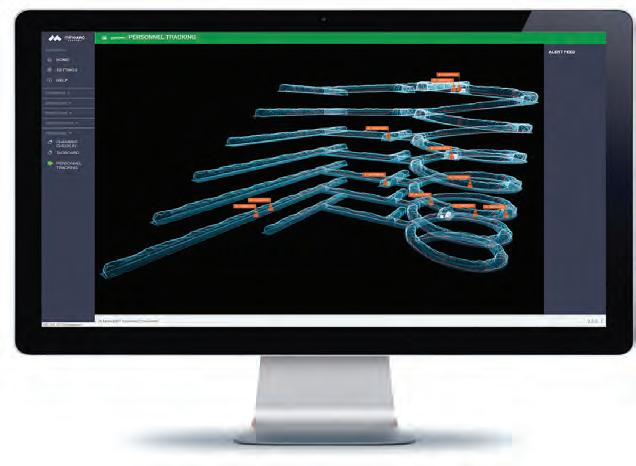
4 minute read
Mining’s guardian angel
MineARC’s Refuge Chambers have saved lives worldwide during mining emergencies.
MineARC’s GuardIAN Intelligence Network: Looking out for your personnel
Underground mine disasters can be a frantic time for workers. Crucial decisions need to be made within a matter of moments; whether it be seeking protection in a safe space, accounting for team members or avoiding harmful gases.
MineARC’s underground refuge chambers can eliminate some of the stress in such high-pressure situations by providing a safe haven with clean, compressed air, mains power connection and direct communication channels to above-ground rescue teams.
Compliant with Australian mining industry guidelines, MineARC’s range of refuge chambers are designed to ensure mine workers can stay inside for at least 36 hours.
Now, the company has launched its next development in safety technology, the GuardIAN Intelligence Network.
GuardIAN provides site-wide real-time data at the operator’s finger tips – from gas monitoring, navigational lighting and personnel tracking, to monitoring an entire fleet of refuge chambers – all from one centralised device on the surface.
Further, site operators are automatically alerted to emergency scenarios or network faults.
MineARC chief innovation officer Brent Pearce and marketing manager Lesley Emery speak to Safe to Work about GuardIAN’s distinct features and how it performs in underground environments.
“A lot of what we’re doing is around increasing safety,” Emery tells Safe to Work. “Helping people to react appropriately in an emergency and navigate to the chamber quickly and easily.
“The refuge chamber monitoring aspect of GuardIAN is very unique to the industry; sites can completely monitor their entire fleet of refuge chambers from the surface.
“Should there be a fault that occurs in the chamber at any time, they’ll get an instant alert and that fault can be resolved very, very quickly, meaning that refuge chambers are fit for operation the moment they need to be used.”
In the event of an emergency, workers sheltering in a MineARC refuge chamber equipped with GuardIAN can communicate face-to-face with the above-ground control room while remaining completely sealed from the outside environment.
Communication with rescuers is not only reassuring in the midst of an adverse event but is also helpful for the EQUIPPED WITH ADVANCED SAFETY FEATURES, MINEARC’S REFUGE CHAMBERS HAVE SAVED LIVES IN MINING EMERGENCIES AROUND THE WORLD. NOW, THE COMPANY HAS TAKEN MINE SAFETY INNOVATION TO THE NEXT LEVEL WITH THE GUARDIAN INTELLIGENCE NETWORK.
mine emergency response teams (ERTs) when prioritising which chambers to attend to first.
“When being utilised in an emergency, you get that full visibility around who’s in the chamber and the ability to communicate from the surface to the chamber,” Emery says.
“The ERTs have the added benefit of knowing which refuge chambers they need to be heading down to first and making them a priority if there’s people underground who are in need of assistance.”
The system is designed to be clear and simple to use, ensuring workers can easily set up for the wait time in the chamber.
Another exciting element to the GuardIAN Intelligence Network is the GuardIAN Gas Node.
Using the same technology as MineARC’s already popular Aura-FX gas monitoring for refuge chambers, the GuardIAN gas nodes provide realtime data and analysis from across the underground mine.
“As soon as a gas level or temperature threshold is ceded, nodes in the vicinity will alert,” Pearce says.
“Some environments are going to have different thresholds to others, so we make the alerts as intuitive and proactive as possible.
“Being connected to a live network, MineARC’s GuardIAN Intelligence Network provides mine sites with real-time data, including monitoring refuge chambers.

you’re looking at close to instantaneous notification to surface control.”
In addition, MineARC provides handheld gas monitors that underground workers can equip themselves with, acting as a redundancy to the node network.
MineARC has also developed GuardIAN tracking nodes that identify the position of workers across the entire mine site. The nodes allow supervisors to be accountable for their subordinates’ wellbeing at all times, as well as smart lighting nodes to help personnel navigate to the nearest refuge chamber, through the use of colour based visual alerts. All nodes are monitored from a single GuardIAN dashboard.
While the GuardIAN Intelligence Network is designed with safety in mind, it also offers operational efficiency and

improved site management.
“Thinking from an asset management perspective, in terms of manually having to inspect 30 to 50 chambers in a large mine – you can do that remotely with GuardIAN,” Pearce says.
“Rather than having to drive around and do all of those checks, you’re getting those notifications and diagnostics fed through to a single screen.”
All diagnostics and real-time monitoring are easily accessible through a secure, locally hosted webpage; compatible with any computer, tablet or smart phone. The GuardIAN system operates on a private network exclusive to the mine, meaning no one can access it from outside the network.
Despite its already unique features, MineARC has big plans for the future and scope of GuardIAN.
The company has a dedicated engineering and research and development department to design new products to complement GuardIAN and the rest of the company’s extensive safety range.
“Connectivity underground can mean a lot of things,” Pearce concludes. “It can be very complex so with GuardIAN, we’ve brought in a product which is easy to install, it’s very durable and it is a complete system for accurate information required in underground mining, where you don’t have access to cell coverage or GPS and other things you take for granted day to day.”










